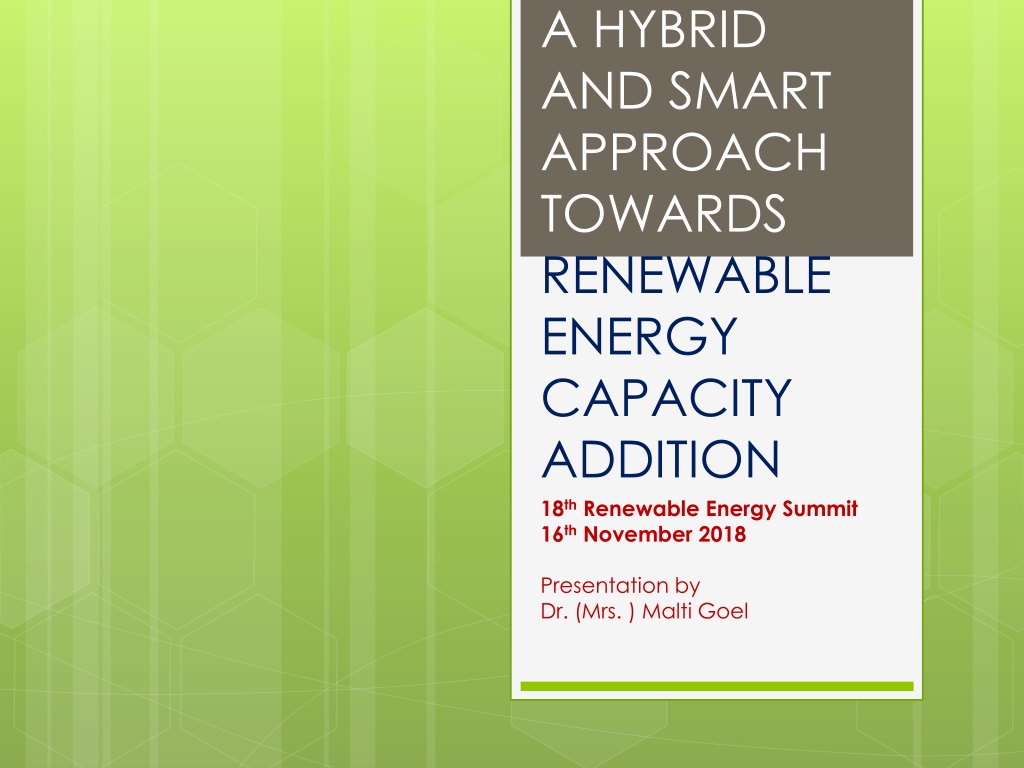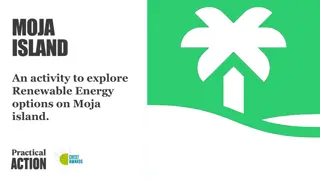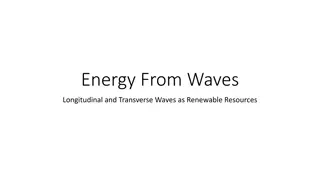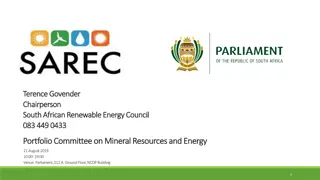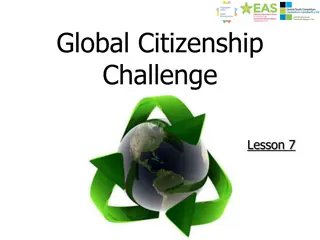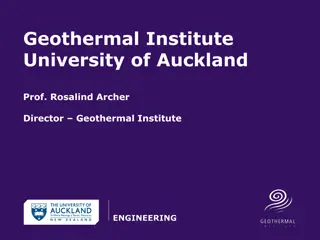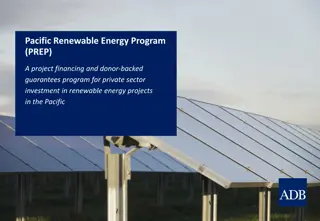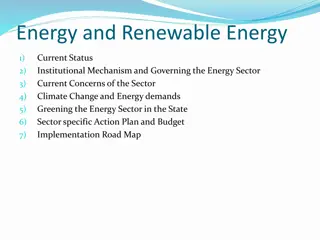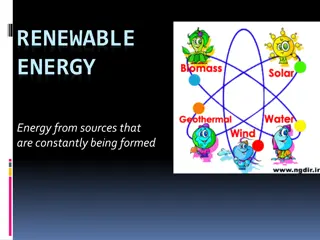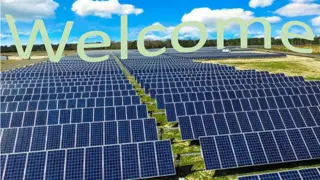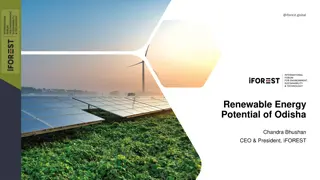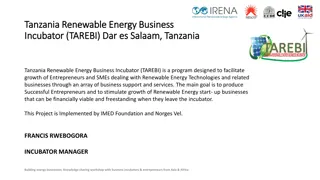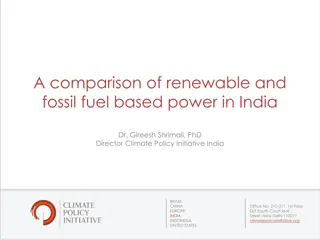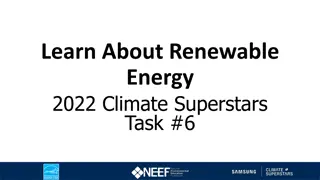Innovations in Renewable Energy: A Smart Approach for Sustainable Future
Explore cutting-edge technologies like Floating Renewable Energy Platforms, Hybrid Energy Systems, Metal Air Batteries, and more, presented at the 18th Renewable Energy Summit. Learn about global renewable energy trends, India's capacity addition, and the potential for renewable power growth by 2030. Discover the potential of floating wind turbines and solar plants for efficient energy generation.
Uploaded on Nov 24, 2024 | 0 Views
Download Presentation

Please find below an Image/Link to download the presentation.
The content on the website is provided AS IS for your information and personal use only. It may not be sold, licensed, or shared on other websites without obtaining consent from the author. Download presentation by click this link. If you encounter any issues during the download, it is possible that the publisher has removed the file from their server.
E N D
Presentation Transcript
A HYBRID AND SMART APPROACH TOWARDS RENEWABLE ENERGY CAPACITY ADDITION 18thRenewable Energy Summit 16thNovember 2018 Presentation by Dr. (Mrs. ) Malti Goel
2 Overview I would like to put before you a five new technologies of relevance to our country to address the theme of the Summit. Floating Renewable Energy Platforms Hybrid Energy Systems HRES with V2G Integration Metal Air Batteries Solar Energy Storage in Water mg@2018
18th Renewable Energy Summit 3 Global Renewable Energy Scene Renewable energy is poised for a global takeoff. Over the past decade, the installed capacity of solar power has increased seven-fold, and wind energy capacity has grown by more than a factor of 13. Wind and solar power are the world s fastest- growing energy sources, with capacity expanding at double-digit rates every year over the current decade Six countries Denmark, Germany, India, Japan, Spain, and the United States account for about 80 percent of global photovoltaic (PV) and wind power capacity mg@2018
4 India s energy in 2010 and Capacity Addition in 2017 mg@2018
5 Global wind capacity and Solar capacity Global Renewable Energy Capacity became 1081GW with China having highest share as a country with one third share of 334GW in 2017 India achieved 61 GW and retained 5th Position, beating Japan at 57 GW According to Renewable Energy Prospects report Renewable power will maintain its strong growth in the Indian market reaching 35% share of generation, and 60% share of power generation capacity by 2030 mg@2018
6 1. Floating Wind Turbines Floating wind turbines are anchored to the seabed using cables without a fixed foundation, meaning they can be placed in water up to 600m, as opposed to 60m mg@2018
7 Floating Solar Plants mg@2018 Floating solar plants had higher efficiency compared to ground-mounted installations due to the moderating effect of water bodies on panel temperature
8 2. Hybrid Energy Systems Hybrid Energy System (HES)s are gradually getting popular for both grid connected and standalone applications as an eco friendly, economical solution. It requires evolutionary algorithm to arrive at optimum system design considering level of grid integration as a constraint. Hybrid Systems allow minimize CO2 emissions mg@2018
9 Hybrid Energy Systems Hybrid Energy Systems bring efficiency mg@2018
10 3. Integration of V2G Concept in Smart Energy Systems Uncertainty of main grid due to changes in demand, increasing renewable energy potential and need for charging of electric vehicles makes it difficult to optimize renewable energy systems with V2G A number of case studies have been conducted in different parts of the world in order to evaluate the economical feasibility of V2G concept in smart energy systems mg@2018
11 Hybrid Renewable Energy Systems with V2G A HRES with V2G consist of SPV panels, wind turbines, V2G charging center and the main grid which supply the electricity demand of an application such as a supermarket or a cluster of houses. Hourly variation of renewable energy potential, V2G fleet capacity for charging/discharging and electricity demand of the micro-grid are taken as major input parameters to the energy model. A novel computational algorithm is developed to optimize smart HRES with V2G. mg@2018
12 V2G Integration in Smart Grid mg@2018
13 4. Metal Air Battery Storage for Vehicles A typical lithium- ion battery can store 150 watt- hours of electricity in 1 kilogram of battery. A lead-acid battery stores only 25 watt- hours per kilogram. https://upload.wikimedia.org/wikipedia/commons/1/13/M etal_air_batteries_barchart.png mg@2018
14 Metal Air Battery for Energy Storage The aluminum air battery is considered to be an attractive candidate as a power source for electric vehicles (EVs) because of its high theoretical energy density (8100 Wh kg 1) mg@2018
15 5. Research on Solar Power Storage in Water NB Institute for Rural Technology (NBIRT), has come up with a prototype of machine that will store solar power in water for 24 hours It has a solar panel, a micro-solar pump, a micro-hydel equipment, a water tank and a water reservoir. solar power is first stored in the underground reservoir and then pumped into the overhead water tank and stored as potential energy. Micro-hydel equipment is then switched on and that will bring the high-pressured, stored solar-powered water into the main machine, which will turn it into electricity. mg@2018
16 Shape of things to come. Bonnet of an Electric Vehicle Thank You mg@2018
